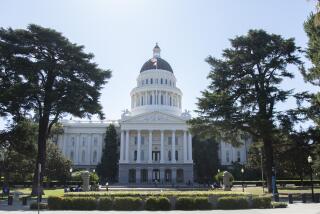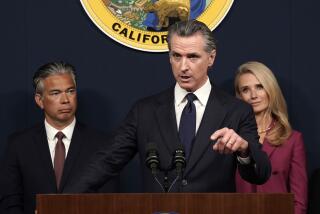California lawmakers bristle at Newsom’s use of executive power during coronavirus crisis

- Share via
SACRAMENTO — When the California Legislature voted to recess in mid-March during the height of concerns over the spread of the coronavirus, few lawmakers realized they were clearing the way for Gov. Gavin Newsom to assume unprecedented control of state government.
The Democratic governor has been widely credited for using his executive authority to prevent a massive surge of the virus early in the pandemic. At the same time, his unilateral decision-making has also fueled bipartisan frustrations in the Legislature, where lawmakers are still struggling to balance the scales of power with Newsom’s administration.
“When we were away, our state government collapsed into one-person rule with a governor issuing, at this point, 41 executive orders changing over 200 California laws with a stroke of a pen,” Assemblyman Kevin Kiley (R-Rocklin) said during the Assembly floor session Wednesday. “But here’s the issue. We’re back now. We’re here. We’re in session. And yet the governor is still issuing executive orders that usurp our legislative authority.”
On Friday, Kiley and Assemblyman James Gallagher (R-Yuba City) won a temporary restraining order against Newsom’s executive action last week imposing new rules for the November election. Their lawsuit alleges that Newsom’s “unilateral action” was unconstitutional. A Sutter County judge blocked the governor’s election guidelines from taking effect until a full court hearing in two weeks.
Tensions between the executive and legislative branches of government are not uncommon. Former Republican Gov. Arnold Schwarzenegger was often at odds with the Democratic majority in the Legislature. Then-Gov. Jerry Brown made history in 2011 when he vetoed the budget hours after lawmakers approved the spending plan.
But the coronavirus outbreak posed a unique challenge at the state Capitol.
As Sacramento County recommended the cancellation of large gatherings, concerns grew about the virus infecting older and other at-risk lawmakers, staff members and the public. With no system in place to vote on bills remotely and the possibility of legal challenges to any laws passed that way, the Senate and Assembly voted on March 16 to approve $1 billion in emergency funds for Newsom to respond to the health crisis and temporarily adjourned.
Three days later and with lawmakers largely sidelined, the governor issued a sweeping executive order shuttering businesses and directing Californians to stay home.
The legislative break that some initially expected to last a few weeks stretched to May 4 as counties statewide implemented health restrictions. Lawmakers had little choice but to sit back and watch Newsom roll out one executive order after the next during his near-daily press briefings. The governor issued more executive orders over three months in response to the pandemic than he signed in all of 2019.
A couple of days after lawmakers returned, Newsom signed an executive order to make it easier for essential workers who contract COVID-19 to obtain workers’ compensation benefits. Labor unions hailed the decision as a win for workers, while business interests questioned the unilateral decision made without any public hearings and outside of the typical legislative process.
Senate President Pro Tem Toni Atkins (D-San Diego) said she doesn’t fault Newsom for stepping up.
“We can Monday-morning quarterback everything that we think he did right or wrong, but California is in the best position, apparently, because of the actions he took,” Atkins said in a meeting Wednesday with The Times’ Editorial Board. “I’m not going to pretend what it would be like to be in his shoes to have to deal with so many issues.”
Jesse Melgar, Newsom’s press secretary, said the governor has been grateful to work with the Legislature during the crisis and looks forward to a continued partnership.
“From the onset of this pandemic, our state has moved swiftly to protect human life and took aggressive and urgent actions to help Californians get through these challenging times,” Melgar said. “Because of those efforts and the actions of millions of Californians who followed the Stay at Home order, California bent the curve — giving the state critical weeks to prepare for this new reality.”
Melgar pointed to executive orders on elections and evictions, and new funding for immigrant workers that he said the governor issued in response to requests from legislators.
Though Assembly Speaker Anthony Rendon (D-Lakewood) has said Newsom didn’t provide much notice before he publicly announced his executive orders, both he and Atkins said they had separate phone calls with the governor a couple of times each week. The Legislature also retained its authority to review the governor’s emergency expenditures.
In April, lawmakers began to voice concerns publicly over the administration’s lack of transparency in deals for personal protective equipment and other emergency purchases. They also issued a strongly worded letter demanding more public disclosure of such deals to allow them to fulfill their oversight roles. Almost a month later, the state provided details of a controversial deal to spend nearly $1 billion on masks.
“If they want to keep asking us for requests for money, they’re going to have step up on their transparency,” said Assemblyman Phil Ting (D-San Francisco), chairman of the Assembly Budget Committee, back in April.
Budget negotiations are also adding to the tensions, as a deadline looms to pass the 2020-21 spending package by Monday. Newsom’s revised budget proposal includes another $2.9 billion in emergency funds to respond to the pandemic, drawing pushback from lawmakers.
“They were asking that that dollar amount be appropriated and allow the flexibility and freedom to kind of spend on his own,” said Sen. Holly Mitchell (D-Los Angeles), who leads the Senate budget committee, during the meeting with The Times’ Editorial Board. “I think it was important for us to remind the administration that the Legislature has a role to play, too, in the decision-making process.”
Prompted by the COVID-19 crisis, this week the Assembly approved ACA 25, a constitutional amendment that would allow lawmakers to vote remotely during a state of emergency that prevents them from safely doing so in person at the Capitol. Both Democrats and Republicans sounded off Wednesday during the floor debate before the vote.
“Some of us tweeted our anger at the governor and continue to tweet our anger at the governor on a daily basis,” Assemblyman Marc Berman (D-Menlo Park) said. “And I think there’s unanimous agreement at that frustration. It’s so important that we continue to be the co-equal branch of government that we are.”
Gallagher, one of the GOP lawmakers challenging Newsom’s election mandate, urged his colleagues to take back their legislative power.
“It only matters if this chamber actually steps up and challenges the governor when he takes over our legislative role,” he said. “And he has done that many times during this pandemic. And we’ve done virtually nothing — done a little bit, complained about it.”
Assemblyman Adrin Nazarian (D-Los Angeles) praised Newsom for his leadership in the “extremely prudent, bold and necessary step” to issue the nation’s first stay-at-home order and said he agreed with several of the governor’s decisions. But as time wore on, he said, Newsom missed an opportunity to receive the Legislature’s backing — and shared responsibility for decisions he ultimately made alone.
“I think we could have been working closer with this administration in trying to address a lot of the areas that he has tried to single-handedly address,” Nazarian said in an interview. “I think we would have been able to both help guide and offer support, and be able to then also justify why we’re making those decisions in collaboration with the administration.”
Sacramento Bureau Chief John Myers contributed to this report.
More to Read
Sign up for Essential California
The most important California stories and recommendations in your inbox every morning.
You may occasionally receive promotional content from the Los Angeles Times.











